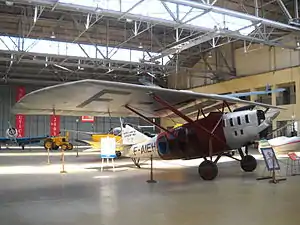Latécoère 25
The Latécoère 25 was a French airliner built in 1925 for use on Latécoère's own airline and its subsidiaries. Essentially a refined version of the Latécoère 17 with an enlarged wingspan, it supplanted that type in production and then in service.
| Latécoère 25 | |
|---|---|
 | |
| Preserved Latecoere 25 displayed at the Museo Nacional de Aeronáutica de Argentina. It wears the markings of Aeroposta Argentina. | |
| Role | Airliner |
| National origin | France |
| Manufacturer | Latécoère |
| First flight | February 1926 |
| Primary user | Lignes Aériennes Latécoère |
| Number built | >50 |
Operational history
As Lignes Aériennes Latécoère increasingly shifted its emphasis from carrying passengers to carrying airmail, the Latécoère 25 found its definitive role as a mail plane, and was widely used in establishing the line's South American services. Airlines which operated the type included Aeroposta Argentina. Like the Latécoère 17, it was a conventional parasol-wing monoplane with enclosed seating for passengers and an open cockpit for the pilot.
One Latécoère 25 was involved in a celebrated incident when it made a forced landing high in the Andes. Hitherto, flights between Buenos Aires and Santiago made a 1,000 km (620 mi; 540 nmi) detour to avoid the mountains. On 2 March 1929, while searching for a safe route across the range, a Latécoère 25 piloted by Jean Mermoz was caught in a downdraught and forced down onto a plateau just 300 m (980 ft) across at an altitude of 4,000 m (13,000 ft). With his mechanic Alexandre Collenot and passenger, Count Henry de La Vaulx, Mermoz spent the next four days repairing and lightening the aircraft and making a clear path from it to the edge of the precipice. He then rolled it off the edge, diving to attain airspeed, and successfully reached Santiago.
Survivors

The only surviving example of a Latécoère 25 is preserved in the Museo Nacional de Aeronáutica de Argentina in Morón. It wears the markings of Aeroposta Argentina.
Variants
- Latécoère 25
- Latécoère 25-2R
- production aircraft
Specifications (Laté 25)
Data from Jane's all the World's Aircraft 1928[1]
General characteristics
- Crew: 1
- Capacity: 5 pax ; 1,068 kg (2,355 lb) useful load
- Length: 9.45 m (31 ft 0 in)
- Wingspan: 17.4 m (57 ft 1 in)
- Height: 3.7 m (12 ft 2 in)
- Wing area: 48.6 m2 (523 sq ft)
- Empty weight: 1,650 kg (3,638 lb)
- Gross weight: 3,283 kg (7,238 lb)
- Fuel capacity: 565 kg (1,246 lb)
- Powerplant: 1 × Renault 12Ja V-12 water-cooled piston engine, 340 kW (450 hp)
- Propellers: 2-bladed fixed pitch propeller
Performance
- Maximum speed: 192 km/h (119 mph, 104 kn)
- Stall speed: 90 km/h (56 mph, 49 kn)
- Range: 850 km (530 mi, 460 nmi)
- Service ceiling: 4,200 m (13,800 ft)
- Time to altitude: 4,000 m (13,000 ft) in 44 minutes
- Wing loading: 67.5 kg/m2 (13.8 lb/sq ft)
- Power/mass: 0.1027 kW/kg (0.0625 hp/lb)
References
| Wikimedia Commons has media related to Latécoère 25. |
- Grey, C.G., ed. (1928). Jane's all the World's Aircraft 1928. London: Sampson Low, Marston & company, ltd. p. 104c.
Further reading
- Taylor, Michael J. H. (1989). Jane's Encyclopedia of Aviation. London: Studio Editions. p. 564.